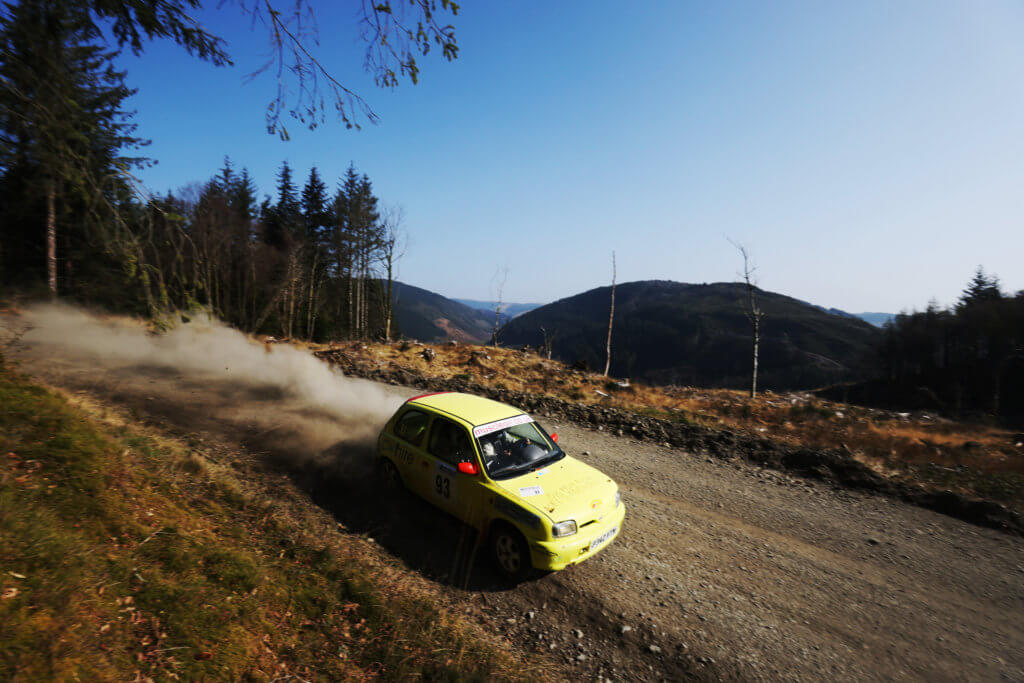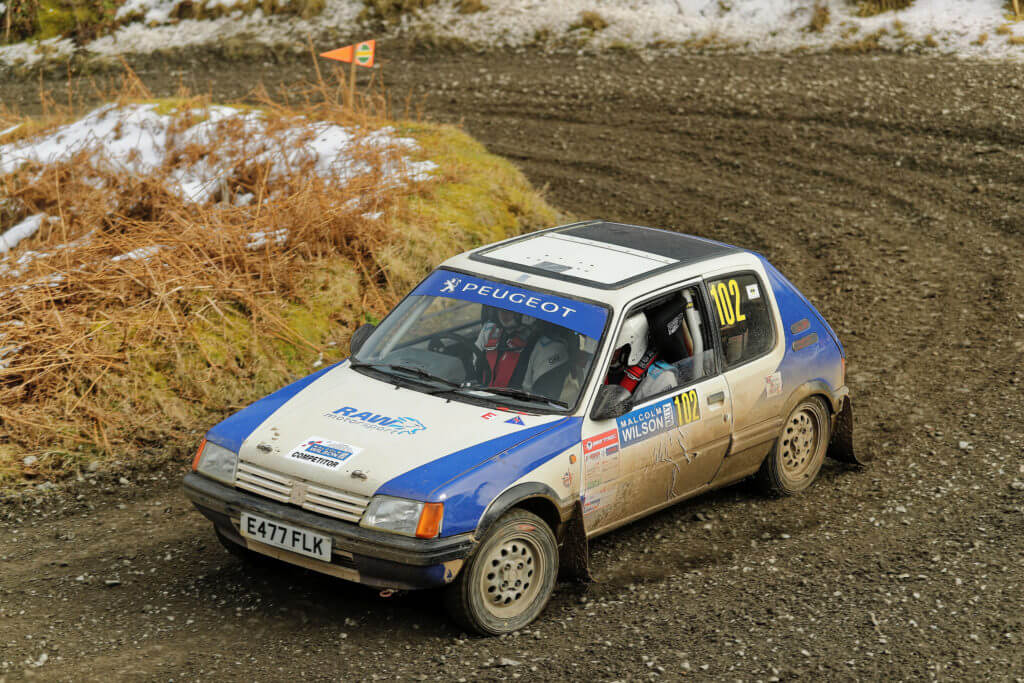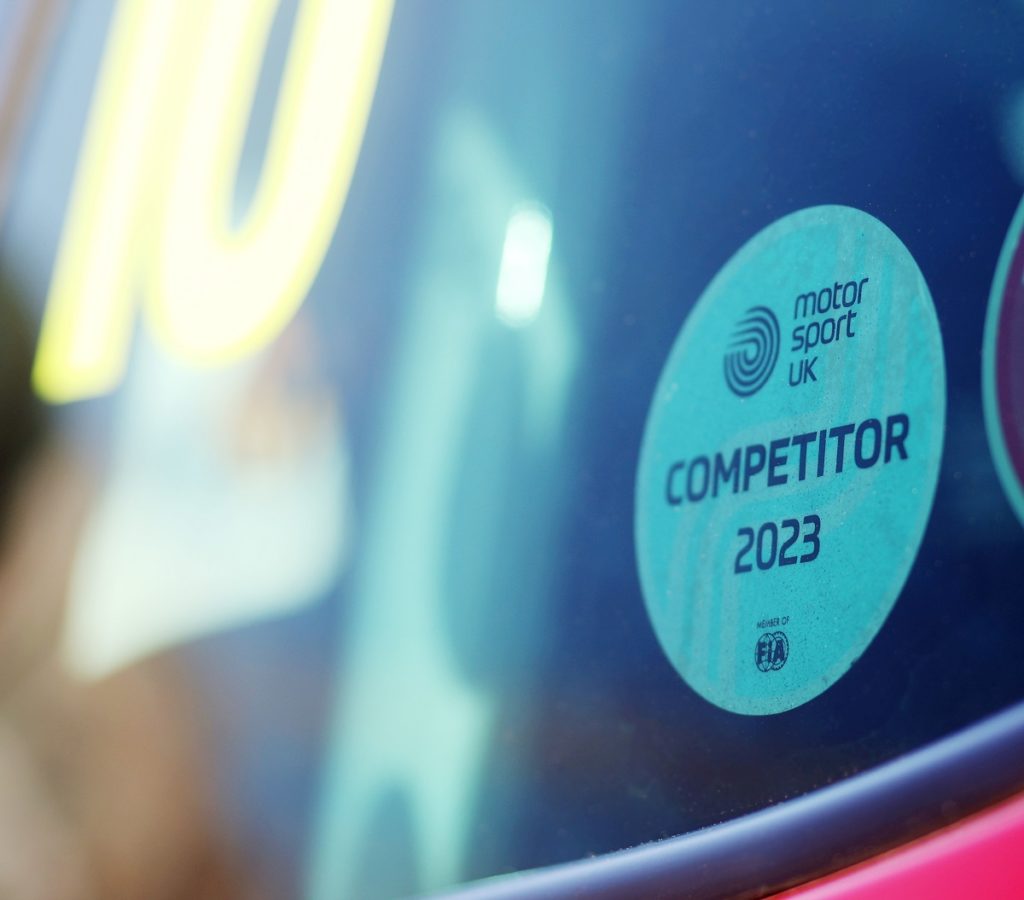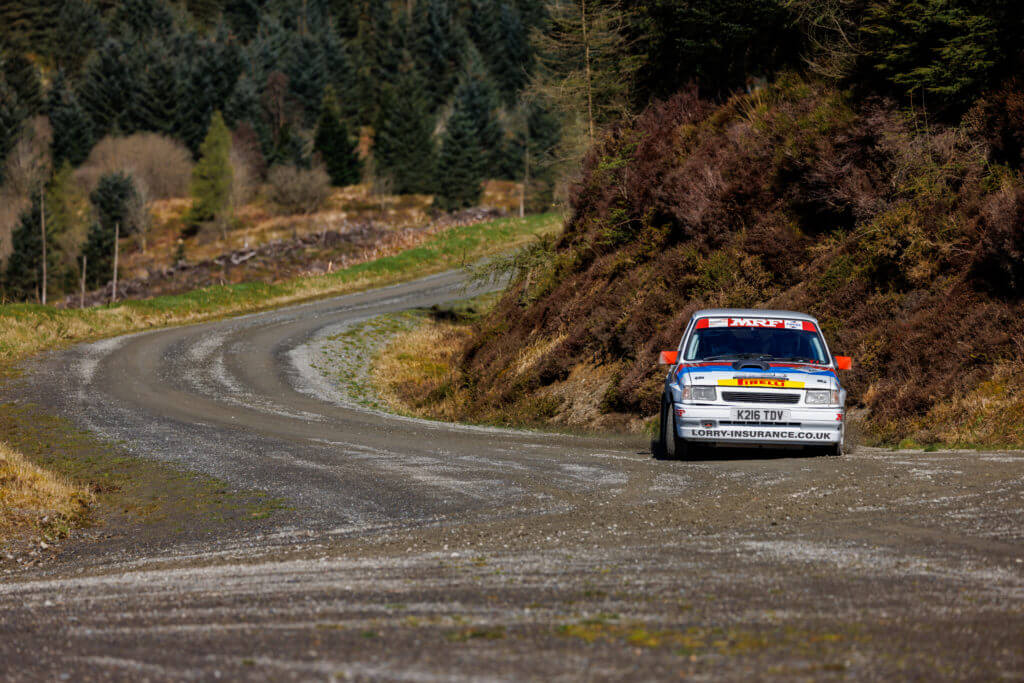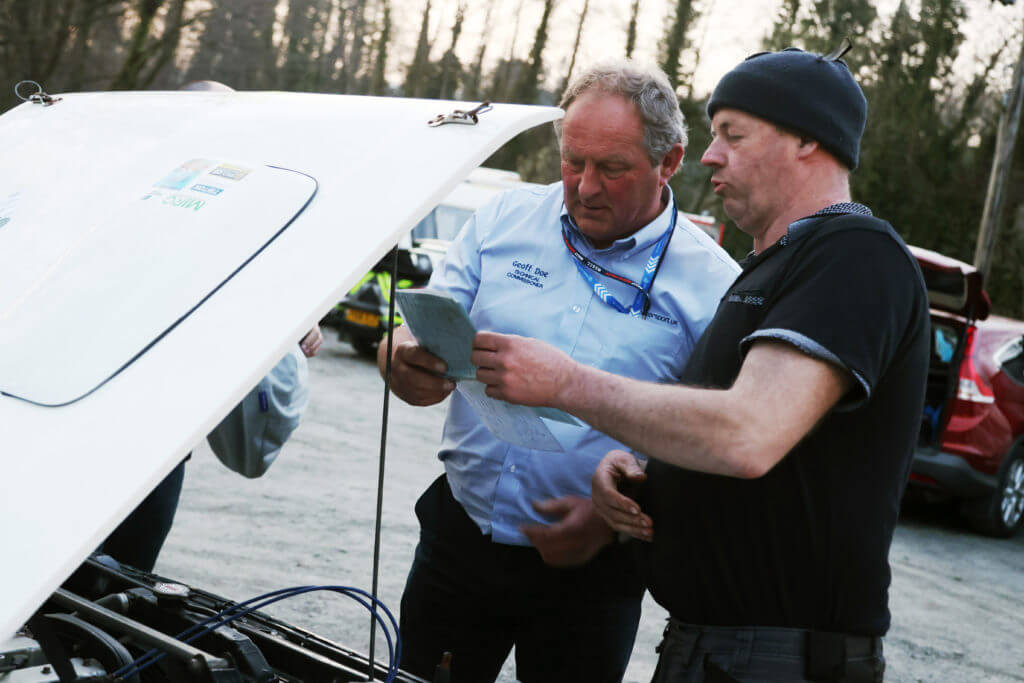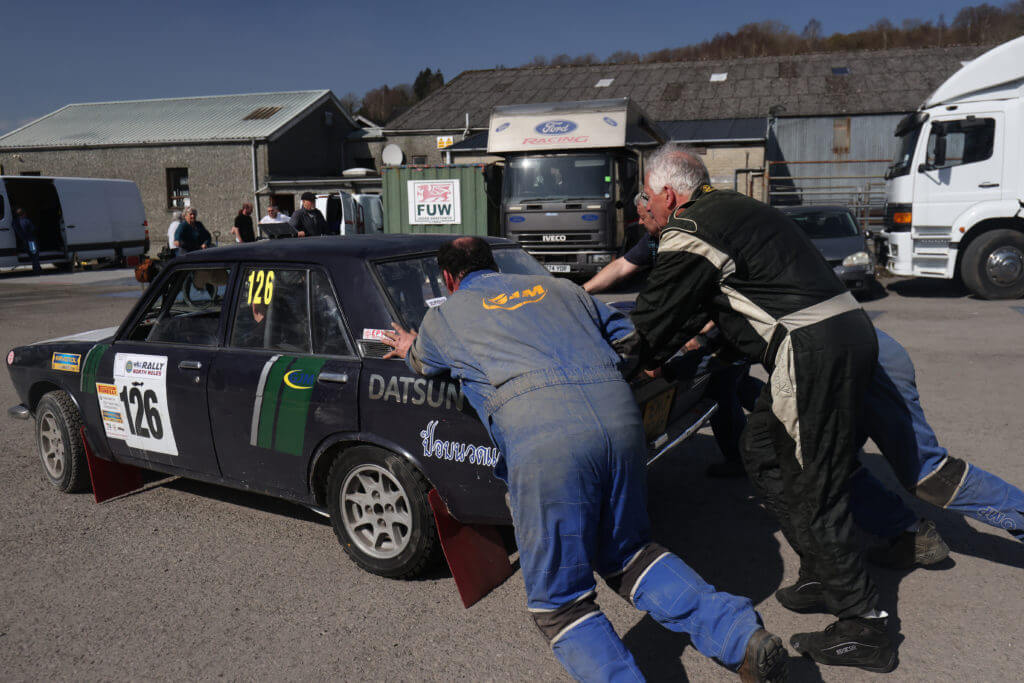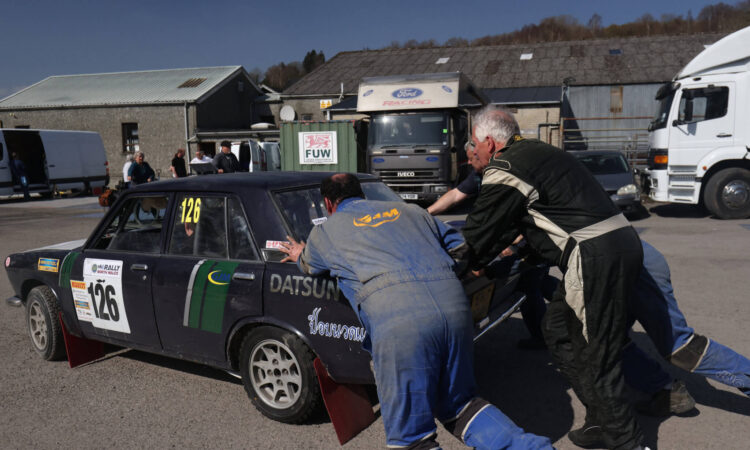
Revolution is available online, as a PDF download and on the Revolution app (for both iOS and Android devices).
Stepping up to Stage Rallying can require deep pockets – but good research, good support and good advice can help cut the costs of competing. Will Gray explains how the dream of competing on a Stage Rally is often cut short by the potential costs involved. However, if you aspire to tackle the famous forest stages in the UK do not be put off by the big numbers that typically get flashed around. Clearly, Stage Rallying will never be in the same cost bracket as pure grassroots motorsport, but there are ways to lower the cost of getting on the stages.
Competing at the top level can cost thousands of pounds per event, but the same can be said for the pinnacle of any motorsport discipline. If you just want to get a taste of the tarmac on a single-venue Rally, or to kick up some gravel on a multi-venue forest event, you need to get a license, buy or share a cheap car, borrow some equipment and get out there.
That is exactly what Will Banks and his co-driver Sam Kelter did last year. Aged just 22 and 25, the Ecurie Royal Motor Club pair took on the Woodpecker and Cambrian Rallies on a budget and had a blast. They are now competing in a full season of the BTRDA Rally Championship, taking on legendary National events like the Malcolm Wilson Rally, Nicky Grist Stages, Kielder Forest and the Trackrod Rally Yorkshire.
“Starting off in Rallying is tough but we are both very lucky because our parents are into the sport and they understand it,” says Will Banks. “I have jumped in at the deep end, straight into forest Rallying, as that is probably the most expensive! We are both pushing our limits on what we can pay, both living with our parents, but it is so worth it!”
Getting a taste
Going straight into a forest or even a tarmac event not only requires some hefty financial investment, it also can be a little bit daunting. Many beginners prefer to get their toe in the water on local Road Rallies first, to better understand the driver / co-driver experience before throwing themselves into an off-road event for the first time.
The most popular Road Rallying events tend to be Navigational Scatters or 12 Car Rallies. These typically take place on public highways and are easily accessible to anyone with a road car, driving licence and free RS Clubman competition licence. They are also part of the StreetCar programme, which is a good way to get into the sport.
Michael Wilding, who has been organising events for more than 25 years with Ludlow Castle Motor Club, explains: “In Road Rallies, you have to have a bit of knowledge about your car and also some skill and discipline, so the best thing to do before going off-road is find yourself a good navigator who has done a bit before and go try out one of these.
“You can only develop the skills through practice and it takes time to learn these things. If you start on the road, it doesn’t cost much to do – just a tank full of fuel and you can do it – and there are lots more of them about than Stage Rallies. It then cuts down the risk when you step up to Stage Rally events”.
That is exactly how it began for Banks, who explains: “My whole family have been into motorsport – I started doing trials riding at four-years-old, developing onto Autograss at 12, and being supported by Jonny Milner, British Rally Champion, and Driver for Toyota in 2015-16 gave me the inspiration to get into Rallying. I started off in Road Rallying.
“I bought a Vauxhall Nova for £2,000 from a chap at my Club and my first event was with a friend, Dafydd Jones, in the Valentine Novice Road Rally. It was a really good entry into the discipline, really relaxed and very simple on navigation. I got third in class, fourth overall on my first ever event, so then I got hooked.
“The reason I went Road Rallying before Stage Rallying was simply the cost. I did not want to spend money on a Stage Rally test and getting a license to not enjoy it. To take part in Road Rallying, all I needed was a free RS Clubman licence and membership of Caernarvonshire and Anglesey Motor Club, which cost about £15.
“My brother Edward Wain also competes in the BTRDA and the year before I started myself, I spent time servicing for him, helping to maintain the car. That really helped to give me an insight to budgets and the format, and what you needed to put together to be competitive on a budget.”
However, Banks’ co-driver Sam Kelter, took a different route. Having also been immersed in cars through his family, he pursued a career in Motorsport Engineering at university. There, one of his course friends was building a Renault Clio to take part in single venue Stage Rallies and, when he was invited to join as a co-driver, he went straight in.
“I had never had that opportunity before, because everybody who I knew was already committed to navigators and partnerships – so I bit his hand off,” recalls Kelter. “We didn’t get very far – we actually retired between stage two and three – but it was still a great experience and it was enough to give me the bug.”
After a few more events with a family friend, Kelter was contacted by fellow Club member Banks and invited to sit alongside him last year. Before the pair took on those forest stage events, however, it was suggested that they test their cockpit compatibility with a Road Rally outing.
“It was Will’s idea to do a Road Rally with him, just to get a feel of working together, and it really worked well,” adds Kelter. “In fact, in reality, I wished I had done a Road Rally before a Stage Rally because to come from nothing into Stage Rallying can be very, very daunting whereas with Road Rallying, everything just made that much more sense.
“They give you a very, very good understanding of how the timing side works and you get the navigational side of things straight away from looking at your map the entire night. It is an ideal step to go from that to a single venue Stage Rally, where you are on a stage diagram. For a road rally navigator, I would imagine it would be a doddle.”
Despite his relatively young age, Banks is now very active in his Club as a member of the Committee and Social Secretary. As part of that, he works hard to encourage those interested in Stage Rallying to first try out some road-based events, particularly the Club’s winter Scatter Rallies.
“We do one a month and we encourage anyone new, from older ages to as young as 12, to get involved. We have more members now than in December last year due to these events,” he explains. “We do navigator training, where experienced navigators from the Club sit down with anyone new and help them learn to read the maps.
“The last one we did we had nine crews out and four of them had someone under the age of 18 involved. We are seeing that influx of people wanting to get involved, but they do not want to commit until they have given it a good try. The Scatters are on a Wednesday night and only take 90 minutes, so they are a perfect introduction.”
Selecting an event
The simplest way to enter the world of Stage Rallying on a budget is to head to one of the many single venue locations around the country – places like Weston Park near Telford, Down Ampney near Cirencester, Anglesey in Wales, Oulton Park in Cheshire, or Leconfield in Yorkshire, to name a few.
Michael Wilding, who is a veteran of both single and multi-venue events, says: “Single venue events are good, not only because the entry fees are a lot less than the forestry rallies, but also because the surface is usually all-tarmac or broken tarmac, with a few potholes, so they are not very damaging on your car.
“Also, if you are a new driver and you are going into some of these corners a bit too quick, and maybe a shower of rain has made it totally different to how it was in the dry, if you do lose it, you often end up going across the field on the grass, so there is nothing for you to hit!
“There are still lots of good straights and corners and some splits, so you need a navigator who is on the ball to be able to direct you. You get plenty of mileage, but as the venues are relatively small, the service vehicle does not have to move anywhere, and you can carry your own fuel to put in the car.”
While these types of events are certainly the most cost-effective way into Stage Rallying, the hook for many is that feeling of flying through a forest with the car dancing on loose gravel. To get that kind of adrenaline, however, is another level again, as it typically involves at least two days of scrutineering and competition, and a whole different perspective.
For those that crave more than a single venue event, Wilding has some sage advice: “Pick one that has been recommended by your local Club. For me this was the Woodpecker Rally. That one is fairly central to the country and the stages are usually as good at the end as they are in the morning. They are the sort of stages that can stand a few cars and do not cut up too much.
“Some other Rallies I have done, like ones on sandy ground, the morning is okay but you go through it in the afternoon and it is all cut up with potholes, totally different to what it was before. So, pick one with quality stages because that will do less damage to your car and cost you less in maintenance in the long run.
“Organisers are usually very honest – they have to be, because the proof of the pudding is there for everyone to see! It is also a good idea to go out spectating, do some single venues and investigate one or two longer events when you are not competing. Then, if you like what you see, you can try it out the following year.
“Speak to the competitors as they come over the finish line and also look in the press to see which events have the biggest entries. Some of them are full several weeks before they run, which is a good sign. If lots of people want to do them, they are popular for a reason – people vote with their feet.”
Ultimately, the most cost-effective balance is perhaps to take on a mix of both. The cost of one forest event is equivalent to two or three single-venue events, so if you are just looking for action, time behind the wheel and the occasional big adventure, it is a good idea to spread your money wisely.
“Single venues are really good to get involved, but everyone also wants the sound of the car going through the forest,” admits Banks. “Budget-related championships or cars, like the Mini Rally Challenge and the MG3 Rally Championship, are growing in popularity and they also have either hire cars or cars with budgets to compete.
“At the end of the day, all the different types of Rallying are great to be involved with and you just need to do what is right for you and your budget.”
For those who are looking to become a co-driver, finding a ride in any type of Rally is not easy. People often step up from Road Rallying to Stage Rallying as a crew, while those who want to compete for the first time will typically want someone alongside them who has had the experience of a few events under their belt.
Turning to social media can sometimes be the answer and Kelter explains: ”On Facebook, there are some forums with thousands of people in them, just in the UK alone. One is dedicated to navigators who want to get their name out there and drivers often put out requests for navigators for specific events.
“If you are in a good Club, you can also get opportunities from that network. If you go to members nights, the kinds of discussions you would have, just chatting with people and understanding what they are hoping to do in the year, can open doors. Just talking, that is the best thing you can do.”
Getting a licence
Anyone wanting to enter a Stage Rally for the first time must obtain a specific licence. This goes beyond the free RS Clubman and comes at a cost of £104 for an RS InterClub Stage Rally or Junior licence, £108 for a National Navigator, or £167 for a National Stage Rally driver. Drivers must also pass a written and practical test at one of the schools accredited by the British Association of Rally Schools (BARS).
Silverstone Rally School is one such venue and Manager Sharon Ford explains: “We do not insist people train with us, they can train out in a field then come and do the test if they want, but we recommend at least doing a half day [training] because then we can talk through everything that would happen at a Rally and give them a lot more chance of passing.
“Co-drivers do not actually need to get a BARS, but fresh out the box we would recommend doing a half or full day navigator course anyway. In fact, quite often we get navigators who do the full BARS test, because then they are a back-up, and it gives them a really good understanding of Rallying.”
The written assessment involves watching a couple of videos before taking a 20-question multiple choice paper. After that, there is a basic on-stage driving assessment where the applicant is talked through what would happen at a Rally and what the signage means. It is all designed to ensure the driver has the basic abilities to make them safe.
Ford adds: “The assessment itself takes about an hour in total and, as long as you have confidence, it is easily achievable. It is the written test people tend to have more of a challenge with because some come in with a bit of gung-ho, thinking they are brilliant drivers, but they have not really studied the Motorsport UK Yearbook and come unstuck.
“The answers are all in the Rally section of the Yearbook, Section R, and they are all safety based. They could be asked about anything – the type of helmet you should have, when you should arm your fire extinguisher, should you have a first aid kit, should you have belt cutters, right down to where particular signs are on a stage.
“People tend not to fail the driving part and on the written test there is some leeway. If we feel that someone has answered the question but not quite got it and after discussion with the instructor they understand, then we can sign them off. If they have 90 per cent of the questions wrong, they need to go away and practice a bit more.”
Banks did his test at the Phil Price Rally School in Wales, spending a day doing some on-stage practice before taking the test itself. He passed with flying colours and enjoyed the experience so much he has been back again for more testing, to help build up his skills beyond the basics.
“As long as you have researched before and watched the videos and just listen you will be fine,” he says. “They are not after the next Colin McRae; they want someone who is going to listen and take onboard the information and advice. They do not want you to get in the test car and set the new record, just to drive safely like you would drive to work.”
It does not have to stop at the BARS Assessment, and spending a bit more up front could pay off in the long-term. A short course can help decide if the sport is for you and, at a cost of just under £200 for a half day, or around £300 for a full day at most schools, the insight you can gain could save you making errors and damaging your car on your first event.
“If you are practicing in a field and you pass your BARS Assessment, happy days, but in my view, you have still not been properly taught the technique that would keep you safe, other people safe and your car safe,” states Ford. “In the long run, that could be very expensive, so it can often be worth getting expert advice.
“We run half-day group experiences where you can learn handbrake turns, power sliding, and then put those two skills together around the whole stage. A full day then moves into pace notes, how to read them, write them and interpret them, so that takes the experience that little bit further.
“The most people we would have on a day is 12 that start, and then six of those will be on half day, leaving six for the second half of the day. You get a lot of track time, there is nice camaraderie, you are watching others, learning from others, so that is a really good way to do it because a one-to-one can be a bit daunting.
“These experience days will give you a really good idea if rallying is something you are interested in and if you want to take it on, we run one-to-one sessions Tuesday through to Friday, pretty much every week, from 30 minutes up to a full day. If you have been on an experience day before, you know what you were good or bad at and what to work on.”
Car and safety kit
One of the biggest outlays when starting out in Stage Rallying is the car itself. Everyday road cars are fine for StreetCar events like Road Rallying, but an off-road event requires specific safety elements such as a roll cage and four-point harness as a minimum. That means the participants need to source a suitable car.
There are a number of different approaches to this and Andy Price, Chair of Potteries and Newcastle Motor Club, says: “You can hire cars, but it is a few hundred pounds for a single venue or around £1,000 for a forest event and you also need a trailer, which is another £100-150, as nobody really drives cars to events.
“You could potentially look into sharing the cost of buying a car or offering to buy a share in one that somebody already owns. If you are not clashing on events, you could quite easily club together like that. I also know of Clubs that have bought cars in the past and let members take them out for different events.
“If you do buy one, there are quite a few on the market, so shop around. You also have to be sure you have all the safety requirements such as roll cages, harnesses, fire extinguishers, cut-off switch and electricals, so for a car that is solid and has all you need, you will not have much change out of five or six thousand pounds.
“Getting one that is already prepared is probably the best way to go, but the problem is you do not always know the full history of the car. If you are mechanically minded and can work on it yourself, you can save a bit of money and you also know what it is all about, so you can perhaps have a bit more confidence in it.”
In April 2022 Revolution featured an article about how to buy a race car, and many of the approaches are the same when it comes to Stage Rallying. Most people source one either through word of mouth, their Club or online, either on specialist sites such as Race Trader, Racecars Direct or on eBay or Autotrader.
Banks already had a Road Rallying car, so he took the route of modifying that up to meet Stage Rally specifications. “I had about 60-70 per cent of what I needed already on the Road Rally car,” he said. “I spoke to Harry Hockley Motorsport, explained I only wanted the essential stuff and it was surprisingly affordable. I did all the shell work myself, got rid of all the rust and fitted a strengthening kit, which was self-explanatory. They were on the phone for any questions then they fitted the roll cage and checked that I had done the right work on the shell.”
Along with the knowledge of the professional engineers, Banks also sought wisdom from family and friends, plus anyone he could find to get the tips and advice on how to ensure the budget-cutting approach was not a corner-cutting approach, and it was all done to the best quality possible. That involved learning quite a few new techniques for himself.
“My dad gave me some good advice at the start,” he recalls. “He said to me ‘do the welding that you will cover up first, then by the end you can do the nice stuff because it will be better with experience.’ Having that guidance within the family was a help, along with the support from the club.
“The best approach is to follow the guidelines in the Motorsport UK Yearbook for safety regulations and also learn from people who have done it before. There are lots of Facebook forums and groups, even ones for specific car models – so, for me it was the Vauxhall Nova Owners Club. There are actually a lot of people out there discussing how to build cars.
“You can also search through Google or Facebook photos to spot different approaches, and the same goes for sold or for-sale car ads. I looked at lots of those to see what they had done. If you do your research, you can avoid having to do things twice, and most motor clubs, even if they only have few members, usually have a huge support network.
“Local scrutineers can also be helpful. My local scrutineer lives 10 minutes down the road, so halfway through building the car he popped down to make sure it was being built right. I think most scrutineers would be happy to see someone ask for help instead of just doing it and turning up to a Rally and it be wrong.”
When it comes to kit – such as helmets, race suits and Frontal Head Restraint (FHR) devices – you do not always have to buy brand new. It is possible to hire them, but if you need to hire the full kit, it will soon add up. This can be useful for a couple of even though, especially if you are still testing out whether you want to fully commit to Stage Rallying.
Event costs
Once the kit and car costs are out the way, the biggest ongoing outlay is entry fees and associated accommodation and travel costs. As mentioned before, single venue events are cheaper than multi-venues, but even so, the cost of taking part in numerous events over the course of a year can quickly stack up.
Banks says he has “dedicated the year” to Rallying after signing up to participate in the eight-round BTRDA Series. That means giving up holidays and going out with friends to save money, but he has also found that by spending time researching the different options out there, the costs can be reduced.
He has also come to an agreement to split the entry costs with co-driver Kelter, who explains: “If I take away half of the entry fee from him, it at least gives him a little bit of spare cash. If anything, he is doing me more of a favour because without him I would not be going Rallying at all.”
Banks still takes on the full cost of maintaining the car, but Kelter adds that he would happily have a conversation on splitting the bill “if anything goes seriously wrong.” Banks’s family has also come up with an innovative way of saving money on hotels, transport and fuel for travel.
“You have to look at the whole weekend,” Banks explains. “Accommodation is a big cost on multi-venue events because scrutineering is on a Friday so you need two nights and every B&B puts the prices up when a Rally is in town. Fortunately, my dad and I made a truck years ago and we use that. The car goes in and it sleeps six, so we save a lot of money.
“At some events, like Rally Nuts, you can pay for camping at the service in addition to the entry fee. At others, we make sure we speak to the organisers before the event, tell them we have got a motorhome / race truck and ask if can we stay at service. They are normally pretty happy for us to do that.
“You just need to do your research when you are looking at events. The Malcolm Wilson, for example, it was hotels or B&Bs so it was difficult to get hold of one. Everyone is trying to save money, so if there is additional camping or you can stay in a van, you are absolutely winning.”
Another way to cut costs is to reduce the number of people that you take along to the event. While it may be preferable to take some extra pairs of hands to support at the service park, if driver and co-driver can handle all the issues that could come up on an event, a leaner team can offer big savings.
Kelter explains: “In November, I did the Glyn Memorial, and we took a lot of people – driver and navigator, two to work on the car, my mum, dad, and brother – we needed three hotel rooms for two nights. Some people just have a driver and co-driver, maybe one extra. It is a lot more stressful without that assistance, but that is something that you need to weigh up.
“Having the truck, we have started to limit how many vehicles we are taking. Myself and Will now go up in it to save taking an extra vehicle, extra fuel and so on. Over the course of a year, that one tank of fuel extra, eight events in the year, that is quite a lot of money just on putting diesel in a van.”
Running costs
The big-ticket items when it comes to competition – major repairs aside – are fuel and tyres. Tyres will wear quickly, particularly on gravel and loose surfaces, and if you want to be competitive and safe, you will probably use around one set per event. If you are competing in a championship or a number of individual events through the year, that can soon become quite a bill to pay.
As for fuel, depending on the power and fuel consumption of your engine, a single-venue event will likely use a full tank, a multiple-venue at least two tanks. When petrol prices change as dramatically as they did last year, that can make a noticeable difference to the outlay required to complete the event.
These two areas are where one of the most difficult compromises comes, as money really does equate to performance. Tyres come at different prices and if you ask a competitor the more expensive choices can make a difference. Likewise, fuel comes at different octane levels, with higher octane giving more performance and protection – but at a higher cost.
“You always want to get the best you can but you have to make careful decisions on what to spend for the best performance,” explains Banks. “I actually entered the 1400C (Bronze Star) class in BTRDA because they put us first on the road, so that reduces the damage on the car, and the lower performance means you will not shred tyres like the R5 cars.
“I can normally do about an event and a half on a set of front tyres, then I put the fronts on the back to maximise their use. So that is about 60 miles on the front tyres. That depends on the weather though – if it is hot, they are going to be shredding more – and if I get a puncture, that is a different matter.”
If you hunt around, there are deals to be done and Banks has managed to reduce his costs by entering the MRF Trophy. Open to all BTRDA Rally classes, it is free to sign up and offers discounted tyres and on-site support in return for decals on the car, with the overall winner getting four sets of free tyres and free entries for the following year.
As for fuel, different series have different official suppliers on site, and competitors have a choice between using these services or picking up their own petrol from forecourt stations. The latter is often cheaper, as you can shop around, but the quality can be uncertain and Banks believes a little extra spend in this area is worth it.
“On our events, you either book fuel from Vital Equipment who are usually at service, plan a petrol station on route or have someone carry your own jerrycan. Higher octane fuel is better, but it does come at higher cost. Last year it was probably the same price during the huge spike in petrol costs so [then] it was a no-brainer, but now it is a little bit higher.”
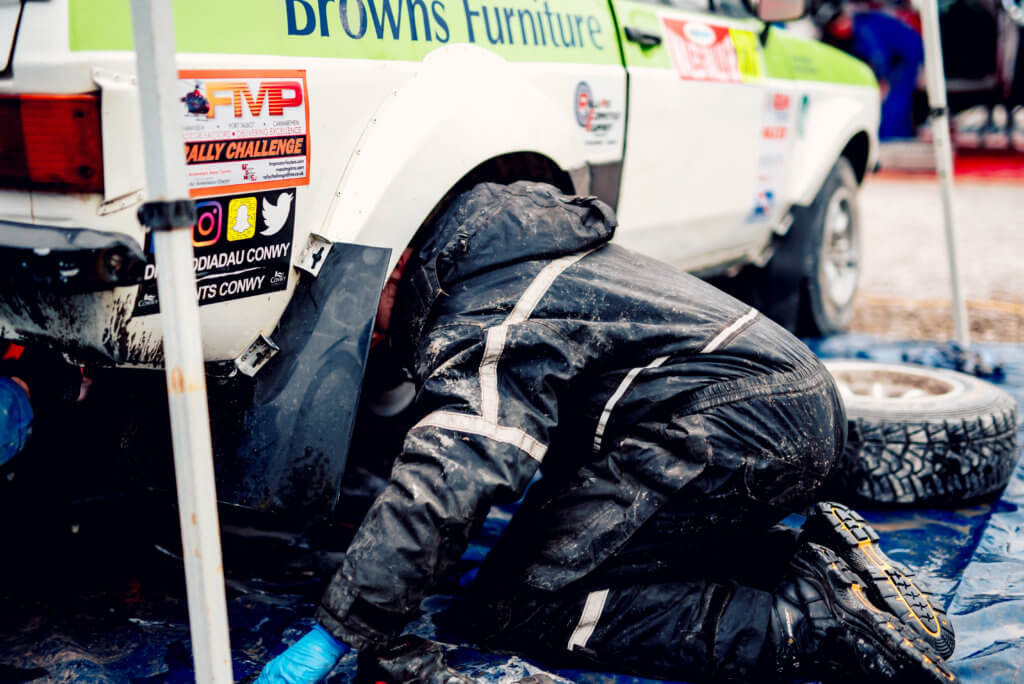
Helping hands
The beauty of Rallying, as with most motorsport, is that it is a very friendly and helpful community. Everyone is keen to encourage newcomers into the sport and happy to field any questions, so to get the best out of a limited budget it is vital to tap into the wealth of knowledge that is available.
There is a huge network online and Banks describes Facebook as “probably the biggest motor club there is” – as not only are there Club pages, but there are also dedicated groups and forums for just about everything. “Everyone is on there and keen to help,” he says. “They love an underdog trying to set up to Rally, because they have been there themselves.”
However, a good Motorsport Club should always be the first point of call, particularly one with a healthy social scene, as members are always keen to support their own. Michael Wilding, who is now Vice President and Competition Secretary at Ludlow Motor Club, joined when he did his first event and has been there ever since.
He suggests: “Go to the local Motor Club where you live, look on their website, look at the chit chat going on and see who is organising what and when. We have great Club meetings, and we have newcomers come along, mix with people that have been doing it for a while and listen and get involved with banter and conversation.
“It is just a matter of talking. Every meeting we have, we talk about who has done what since the last meeting, telling all sorts of stories, so everybody gets to hear about things that happen out there and pick it up as they go along. We are happy to guide anybody if they just turn up and ask.”
Banks agrees, adding that the benefits from attending a good Club night can be far bigger than you might think. Not only can you find out about the best events and discuss money-saving tips, you can also build up relationships that you can take out on the road, giving you a network of helping hands all the way to service park.
“Every week on a Wednesday we go up to a pub and we normally get between 10-50 members turn up,” he says. “When you are building a car, everyone else has done similar stuff when they started off, so it is good to have that advice. Nobody hides anything from the Motor Club, it is quite an open book.
“As an example, we recently discussed fire extinguishers. There are so many different ones you can buy ranging from £200 to £1,000s. Having that inside knowledge from people who have already done the research and made the mistakes saves you a lot of money and time. It is the little things like that that can really help your budget.
“Having that community around you also helps when you go out on events. When we go to a Rally, if someone else from the Club is also there we always try to park together at service and help each other out. There is a wealth of experience, and everyone is happy to support each other.
“On my navigator’s first event he was reading pace notes for a forest rally for the first time and four people from our Club were there, Graeme Wood, Noel Murphy, Kevin Booth, Shaun Hughes. They are all previous winners with top teams and they sat down with him for almost three hours going through the notes to reassure him he was doing it right.”
That co-driver, Kelter, has been going to the Club with his dad for years, and for him it is the depth of knowledge that is most impressive. He adds: “It can go right down to getting an insight on a specific corner in a specific forest – and that could end up helping you avoid a mistake and make sure you get back home with a car in one piece.
“The best part of Clubman rallying is that you are all there for the same thing and people will even lend you a spare if it means you can get back out again and give it back later. The support is amazing. I was a nervous wreck for my first event and without the support from people at the Club there is no way I would have done it.”
Discover more from Revolution

